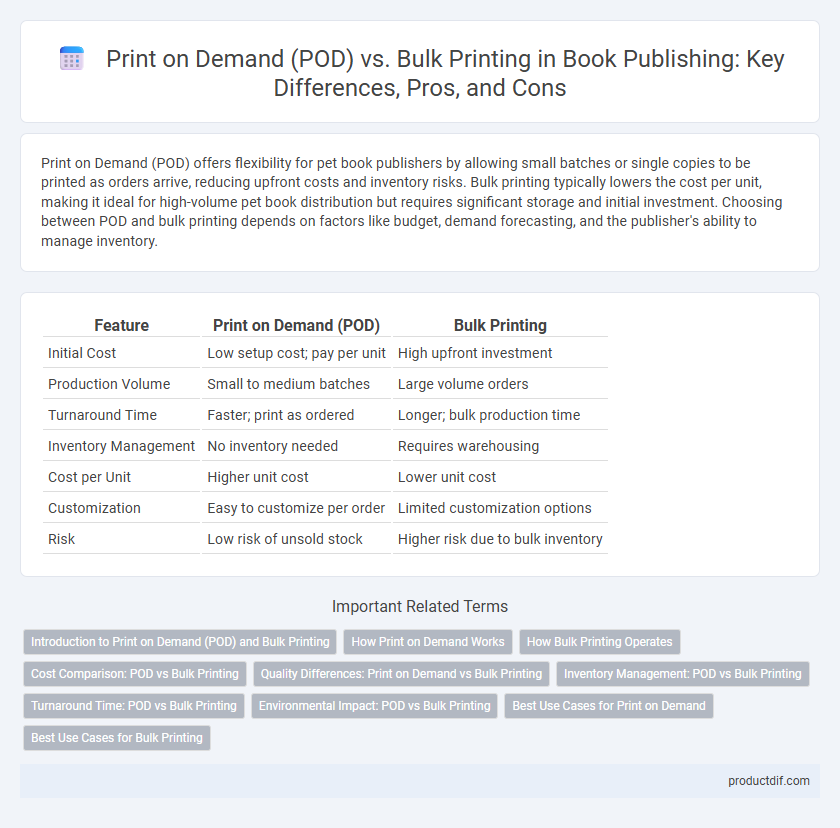Print on Demand (POD) offers flexibility for pet book publishers by allowing small batches or single copies to be printed as orders arrive, reducing upfront costs and inventory risks. Bulk printing typically lowers the cost per unit, making it ideal for high-volume pet book distribution but requires significant storage and initial investment. Choosing between POD and bulk printing depends on factors like budget, demand forecasting, and the publisher's ability to manage inventory.
Table of Comparison
| Feature | Print on Demand (POD) | Bulk Printing |
|---|---|---|
| Initial Cost | Low setup cost; pay per unit | High upfront investment |
| Production Volume | Small to medium batches | Large volume orders |
| Turnaround Time | Faster; print as ordered | Longer; bulk production time |
| Inventory Management | No inventory needed | Requires warehousing |
| Cost per Unit | Higher unit cost | Lower unit cost |
| Customization | Easy to customize per order | Limited customization options |
| Risk | Low risk of unsold stock | Higher risk due to bulk inventory |
Introduction to Print on Demand (POD) and Bulk Printing
Print on Demand (POD) is a digital printing technology that allows books to be printed individually or in small quantities as orders are received, minimizing inventory costs and reducing waste. Bulk printing, or offset printing, involves producing large quantities of books at once, benefiting from lower per-unit costs but requiring significant upfront investment and storage space. POD suits self-publishing authors and niche markets, while bulk printing is ideal for high-volume runs and traditional distribution channels.
How Print on Demand Works
Print on Demand (POD) technology allows authors and publishers to produce books only after an order is placed, eliminating the need for large upfront inventory. This process leverages digital printing methods that enable rapid, cost-effective production of single copies or small batches directly from digital files. POD reduces storage costs and minimizes waste, making it an efficient solution for self-publishing and niche markets.
How Bulk Printing Operates
Bulk printing operates by producing large quantities of books in a single print run, significantly lowering the cost per unit compared to smaller batches. This traditional method uses offset printing technology, which offers high-quality results and faster production times for extensive orders. Inventory storage and upfront investment are critical factors influencing bulk printing decisions for publishers and authors.
Cost Comparison: POD vs Bulk Printing
Print on Demand (POD) offers lower upfront costs by eliminating inventory and reducing storage fees, making it ideal for small-run or niche books. Bulk printing significantly reduces the cost per unit due to economies of scale, but requires higher initial investment and carries risks of unsold stock. For authors and publishers, choosing between POD and bulk printing hinges on balancing cost efficiency against volume demands and market certainty.
Quality Differences: Print on Demand vs Bulk Printing
Print on Demand (POD) typically offers lower print quality compared to bulk printing due to digital printing limitations, resulting in less consistent color accuracy and paper quality. Bulk printing employs offset or lithographic methods, producing sharper images and more uniform text with higher resolution and better ink absorption. Quality variations in POD are more noticeable in large-volume orders, whereas bulk printing ensures consistent output across extensive print runs.
Inventory Management: POD vs Bulk Printing
Print on Demand (POD) eliminates the need for large inventory storage by producing books only when orders are placed, significantly reducing upfront costs and the risk of overstock. Bulk printing requires substantial inventory management to handle large print runs, leading to higher storage expenses and potential wastage from unsold copies. Efficient inventory control in POD supports just-in-time fulfillment, whereas bulk printing demands accurate demand forecasting to avoid stockouts or excess inventory.
Turnaround Time: POD vs Bulk Printing
Print on Demand (POD) offers faster turnaround times by producing books only after an order is placed, enabling authors and publishers to fulfill orders within days. Bulk printing requires longer lead times due to setup, large print runs, and shipping, often taking several weeks before books are ready for distribution. For time-sensitive releases and small quantities, POD provides a significant advantage over traditional bulk printing methods.
Environmental Impact: POD vs Bulk Printing
Print on Demand (POD) significantly reduces environmental impact by minimizing waste and overproduction compared to bulk printing, which often results in surplus unsold books and increased resource consumption. POD uses digital technology to produce individual copies only when ordered, lowering paper usage and energy expenditure. Bulk printing, while cost-effective for large runs, generally leads to higher carbon emissions and deforestation due to large-scale paper manufacturing and storage requirements.
Best Use Cases for Print on Demand
Print on Demand (POD) is ideal for authors and publishers seeking low upfront costs and flexible inventory management, especially for niche markets and limited editions. It enables instant order fulfillment, reducing storage expenses and minimizing waste through printing only when orders are placed. POD is particularly effective for self-published authors, test markets, and titles with unpredictable demand, whereas bulk printing suits large print runs with consistent sales forecasts.
Best Use Cases for Bulk Printing
Bulk printing is ideal for authors and publishers anticipating high demand or distribution across multiple channels, as it significantly reduces the per-unit cost compared to Print on Demand (POD). Large print runs enhance color consistency and overall print quality, making bulk printing preferable for marketing materials, textbooks, or series with established audiences. Inventory management and upfront investment are crucial considerations when opting for bulk printing, as it requires storage space but enables faster fulfillment and increased profit margins on each copy sold.
Print on Demand (POD) vs Bulk Printing Infographic

 productdif.com
productdif.com